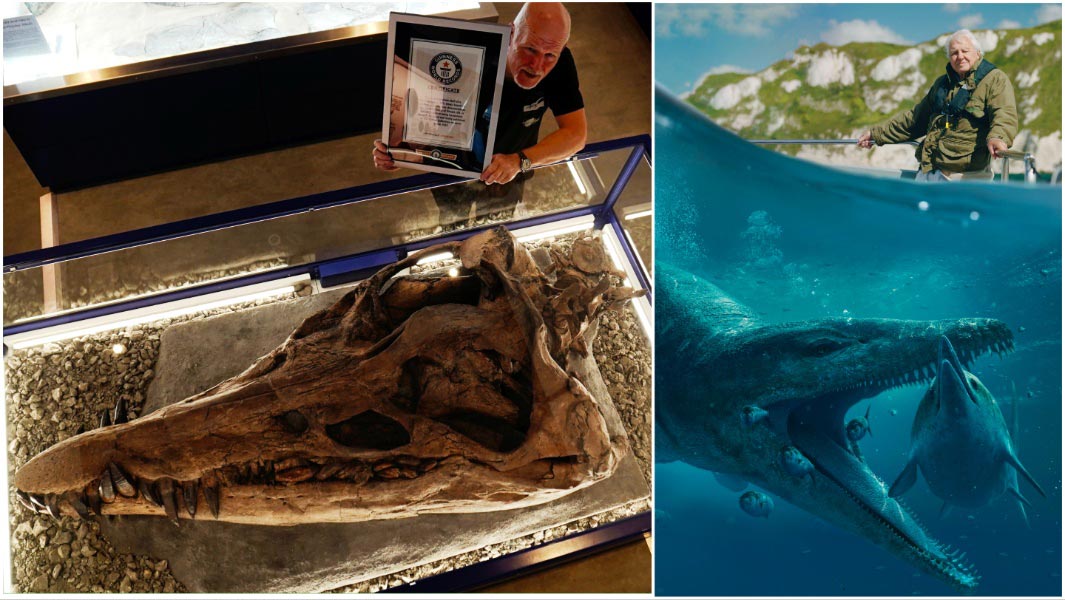He found a sea monster skull from 150 MILLION years ago at the beach!

Do you enjoy visiting the seaside? 🏖️
With the summer holidays getting closer, many of us will be dreaming of the perfect trip to the beach – which probably involves eating ice cream, splashing in the waves and building sandcastles.
But the ideal day by the sea for fossil hunter Phil Jacobs is a little different: he likes to go in search of the remains of pre-historic animals.
And luckily, his dream became a reality in August 2022, when he spotted the fossilized nose of a sea monster from 150 million years ago! 😮

Phil was enjoying a stroll along Kimmeridge Bay in Dorset, when his eyes were drawn to what looked like the tip of a snout sticking out of the gravel.
It would turn out to belong to a pliosaur, a type of marine reptile that prowled the seas at the same time that dinosaurs such as Stegosaurus lived on land.
Have you ever found anything cool? 🕵️♂️
Excited by his discovery, he rang his friend and fellow fossil enthusiast, Dr Steve Etches, who owns the local Etches Collection museum in Kimmeridge.
Teamwork makes the dream work. ❤️

After locating where the snout had fallen from, Steve and a huge team spent 3 weeks excavating the cliff to try and find more of the pliosaur’s skeleton. 🧗
“It was a monumental task,” he told us. “There was a lot to undertake and having a tight deadline created a lot of pressure.
“During this time, we faced the very real possibility that we might fail to extract the skull, let alone in 1 piece.”
However, the team persevered and consequently uncovered a world record: the most complete Pliosaurus skull.
A reminder to NEVER give up! 😊

With the skull successfully recovered, Steve then spent around 10 months cleaning and restoring it in his cutting-edge fossil laboratory.
The fossilized pliosaur head, which is about 0.6 m (2 ft) wide and just under 2 m (6 ft 6 in) long, is approximately 95% intact.
It includes both jaws, some of the spine, and 130 teeth! 🦷
Steve, who has been collecting fossils since the age of 5, said: “It stands highly amongst my discoveries, not only because of its size but it’s amazing to have such a complete example of this top of the food chain predator.”
Did you know that a skull can reveal more about an animal than any other part of its skeleton? 💀
It can tell us about the species’ diet, habits and survival methods.

So, what do we know about pliosaurs? 🤔
Here are some fun facts to help you become a sea monster specialist:
- The biggest pliosaurs, such as Pliosaurus, are believed to have reached 10–12 m long (32–39 ft) when fully grown, with their skulls alone measuring around 3.7 m (12 ft 1 in) – that’s equivalent to 4 guitars! 🎸
- They had 4 flipper-like limbs which helped them to cut through the water at high speed. 🌊
- When pliosaurs existed during the Jurassic and Cretaceous Periods, they were the apex predators of the sea – they sat at the top of the food chain and were unsurprisingly feared by most other animals. 😱
- On average, they weighed 45 tonnes (99,208 lbs) – that’s akin to 13 hippos! 🦛 🦛 🦛 🦛 🦛 🦛 🦛 🦛 🦛 🦛 🦛 🦛 🦛
- Pliosaurs had large, razor-sharp teeth, suggesting their diet included fish, squid and other marine reptiles. 🐟

Here at Guinness World Records, pliosaurs are one of our many record-breaking animals, having possessed the strongest bite for a marine reptile ever. 🏆
Larger members of the group are estimated to have had a maximum bite force of between 33,000 and 48,728 Newtons.
In comparison, a lion’s average maximum bite force is 4,000 Newtons and a human’s is a measly 700!
This meant that they could kill their prey with a single bite!
I definitely wouldn’t want to come up against a pliosaur! 😨

So, what’s next for Steve and the excavation team?
Once they’ve got the permission and money to do so, they will return to the bay and attempt to unearth the rest of the pliosaur’s skeleton from the cliff. ⛏️
Like Steve, palaeontologist Dr Judyth Sassoon is extremely excited to see what else might be hiding in the cliffs: “If the rest of the skeleton were to be found intact, it could potentially be the most unique pliosaur specimen anywhere in the world.”

She added: “I have studied many Kimmeridgian pliosaurs but have never seen one that is quite so well preserved as the Etches pliosaur. 👏
“It contains a lot of anatomical details in a single specimen, that are only found partially preserved in other specimens.”
The skull is currently on display at The Etches Collection, along with over 2,500 different fossils. 🐚

Has this story inspired you to become a fossil hunter? 💭
If so, here are some top tips from Steve to get you started: “It is key to put in the necessary time and effort to not only collecting but understanding what [you] wish to achieve and [your] area of focus.
“[You] need to decide what [you] wish to find as this will help decide collecting locations.”

Where would you like to go treasure hunting? 🔎
Now you’re a pliosaur expert, put your knowledge to the test with our marine animals quiz!
Good luck. 🤞
